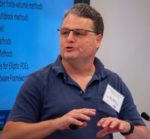The ExaSky project, one of the critical Earth and Space Science applications being solved by the US Department of Energy’s (DOE’s) Exascale Computing Project (ECP), is preparing to use the nation’s forthcoming exascale supercomputers. Exascale machines will enable the ExaSky team to verify the gravitational influences, gas dynamics, and astrophysical inputs that they use to model the universe at unprecedented fidelity, as well as address forthcoming challenge problems to predict and replicate high-accuracy sky survey data.
Dan Martin from Berkeley Lab takes on new role at Exascale Computing Project
The DOE Exascale Computing Project (ECP) has named Dan Martin, a computational scientist and group lead for the Applied Numerical Algorithms Group in Berkeley Lab’s Computational Research Division, as team lead for their Earth and Space Science portfolio within ECP Application Development focus area. Martin replaces Anshu Dubey, a computer scientist at Argonne National Laboratory. “I am confident that Dan’s technical expertise and deep experience with the codes that are relevant to the ECP portfolio make him a good fit to replace me at ECP. Not only is he highly respected for his work, but his management style will mesh very well with the leadership team,” said Dubey of Martin’s appointment.
Podcast: Earth and Space Science for Exascale
In this podcast, Anshu Dubey of Argonne National Laboratory describes the Earth and Space Science application portfolio in the Exascale Computing Project (ECP). “By and large, these applications are solving partial differential equations, and so there is that generality,” Dubey said. “Most times, the range of scales is so huge that you cannot resolve every scale, so then you have to do something called subgrid models, which can be very boutique.”
Podcast: Will the ExaSky Project be First to Reach Exascale?
In this Lets Talk Exascale podcast, Katrin Heitmann from Argonne describes how the ExaSky project may be one of the first applications to reach exascale levels of performance. “Our current challenge problem is designed to run across the full machine [on both Aurora and Frontier], and doing so on a new machine is always difficult,” Heitmann said. “We know from experience, having been first users in the past on Roadrunner, Mira, Titan, and Summit; and each of them had unique hurdles when the machine hit the floor.”
Video: Flying through the Universe with Supercomputing Power
In this video from SC18, Mike Bernhardt from the Exascale Computing Project talked with Salman Habib of Argonne National Laboratory about cosmological computer modeling and simulation. Habib explained that the ExaSky project is focused on developing a caliber of simulation that will use the coming exascale systems at maximal power. Clearly, there will be different types of exascale machines,” he said, “and so they [DOE] want a simulation code that can use not just one type of computer, but multiple types, and with equal efficiency.”








